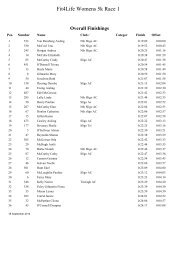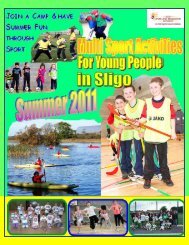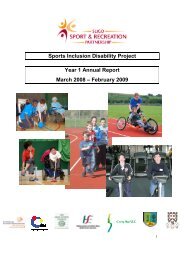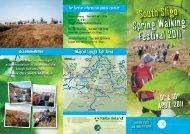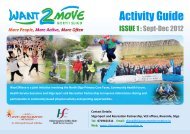Girls Active Programme - Sligo Sport and Recreation Partnership
Girls Active Programme - Sligo Sport and Recreation Partnership
Girls Active Programme - Sligo Sport and Recreation Partnership
Create successful ePaper yourself
Turn your PDF publications into a flip-book with our unique Google optimized e-Paper software.
Introduction<br />
<strong>Girls</strong> <strong>Active</strong> is a physical activity programme<br />
targeting teenage girls in schools in the northwest<br />
region of Irel<strong>and</strong> 1 . This report is an evaluation of<br />
the first two years of the programme. Its purpose<br />
is to provide feedback to the support organisations<br />
on the extent to which <strong>Girls</strong> <strong>Active</strong> has achieved<br />
its aims <strong>and</strong> objectives. In addition, the report<br />
provides information that may be useful to those<br />
who are interested in developing physical activities<br />
for teenage girls. It will also assist future policy<br />
development for physical activity in schools.<br />
Section 1 of the report provides information on<br />
the background <strong>and</strong> origins of the <strong>Girls</strong> <strong>Active</strong><br />
programme. Section 2 presents more detailed data<br />
on the implementation <strong>and</strong> characteristics of the<br />
programme. Section 3 describes the methodology<br />
utilised in the evaluation. The findings are outlined<br />
in Section 4 <strong>and</strong> discussed in Section 5. The<br />
recommendations arising from the findings are<br />
presented in Section 6.<br />
1.1 Context<br />
Research in Irel<strong>and</strong> <strong>and</strong> other countries indicates<br />
that girls <strong>and</strong> women are underrepresented at<br />
many levels of sport. Females of all ages participate<br />
in sport <strong>and</strong> recreational activity less than boys<br />
<strong>and</strong> men do, are relatively absent from media<br />
portrayals of sporting achievements <strong>and</strong> are poorly<br />
represented at decision-making levels 2 .<br />
Not only are teenage girls less physically active than<br />
boys, many of them engage in very little physical<br />
activity. A recent Irish study reported that over onefifth<br />
of secondary school girls engage in non-PE<br />
(Physical Education) sports on less than one day<br />
per week, twice as many as boys 3 . As habits in<br />
relation to physical activity are developed at an<br />
early stage <strong>and</strong> tend to be reproduced throughout<br />
later life, it is not surprising to find that adult women<br />
also engage in sport to a lesser extent than men.<br />
Recently published figures in an Irish context<br />
indicate that 25% of women participate in sport<br />
regularly compared to 41% of men 4 . This relative<br />
inactivity has negative consequences for the lifelong<br />
health of girls <strong>and</strong> women. The benefits of regular<br />
physical activity include a feeling of wellbeing <strong>and</strong><br />
a reduced risk of obesity, heart disease, some<br />
cancers, osteoporosis <strong>and</strong> depression 5,6 .<br />
<strong>Girls</strong> <strong>Active</strong> is a joint initiative between the Health<br />
Service Executive West (HSE West, formerly the<br />
North Western Health Board), <strong>Sligo</strong> <strong>Sport</strong> <strong>and</strong><br />
<strong>Recreation</strong> <strong>Partnership</strong> (SSRP), Donegal <strong>Sport</strong>s<br />
<strong>Partnership</strong> (DSP) <strong>and</strong> Youth <strong>Sport</strong> West (YSW).<br />
The programme aims to increase the number of<br />
teenage girls involved in long-term regular physical<br />
activity through developing more supportive<br />
environments in schools. <strong>Girls</strong> <strong>Active</strong> commenced<br />
in 2003.<br />
1.2 Background<br />
The <strong>Girls</strong> <strong>Active</strong> <strong>Programme</strong> was developed<br />
in response to numerous strategic initiatives in<br />
the areas of health <strong>and</strong> sport. The publication of<br />
The National Health Promotion Strategy 2000-<br />
2005 7 , the National Survey of Lifestyle, Attitudes<br />
<strong>and</strong> Nutrition 8 <strong>and</strong> the National Cardiovascular<br />
Strategy 9 were central in this regard. Both the<br />
National Health Promotion Strategy <strong>and</strong> the<br />
National Cardiovascular Strategy target teenage<br />
girls as a priority group for the promotion of<br />
healthy lifestyle choices. The former highlights the<br />
need to “identify models of good practice which<br />
encourage young people, especially young girls, to<br />
participate in physical activity”. The Strategy also<br />
identifies schools as appropriate settings for the<br />
implementation of health education programmes<br />
by presenting the concept of the “health promoting<br />
school” as a place that is “constantly strengthening<br />
its capacity as a healthy setting for living, learning<br />
<strong>and</strong> working” 10 .<br />
Under the <strong>Programme</strong> for Prosperity <strong>and</strong> Fairness<br />
the Irish <strong>Sport</strong>s Council (ISC) set up the first<br />
Local <strong>Sport</strong>s <strong>Partnership</strong>s (LSPs) in 2001. These<br />
were initiated to create a national structure to coordinate<br />
<strong>and</strong> promote the development of sport<br />
at local level particularly in disadvantaged areas.<br />
In recognition of the growing awareness of the<br />
Evaluation of the <strong>Girls</strong> <strong>Active</strong> <strong>Programme</strong> - 2003 – 2005 Report 3



